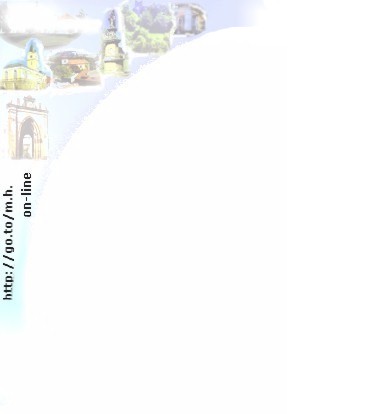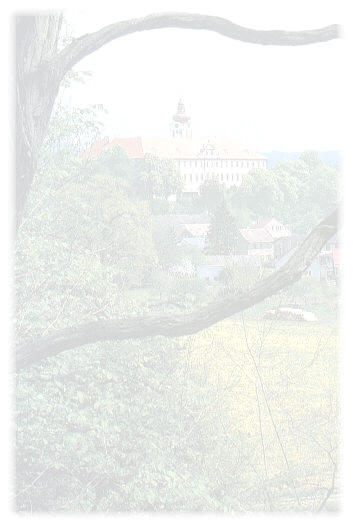Vážení surfaři,
vítáme Vás stránkách o
Mnichovohradišťském Zámku
Právě si čtete o zámku, jehož historie je úzce spjata s bývalým, blízce
vzdáleným Cisterciátským klášterem.
První důležitý vlastník tohoto zámku byl vůdce českých velkostatkářů
a protestant na straně opozice Václav Budovec z Budova. Ten si nechal přestavit
existující zámek na representační sídlo, které by odpovídalo Budovcově
postavení ve společnosti. Po té co velkostatkářská opozice byla poražena
roku 1621, Budovec byl popraven a jeho majetek byl zkonfiskován. Tento
majetek, tak jako další zámky a panenství, získal Albrecht z Valdštejna.
V roce 1627 Albrecht dal své vlastnictví, MH Zámek, svému
bratrancovi Maxmiliánu z Valdštejna. Až do roku 1946 zámek byl
vlastněn Valdštejny, a proto Mnichovo Hradiště bylo po celou tu dlouhou
dobu středem celé Valdštejnské éry.
V pol. 17. stol. byl renesanční Mnichovohradištský Zámek přestavěn
staviteli M.A. Canecallim a M. Raimondim na dnes už vypadající barokní
styl. Rozvoj zámeckého areálu byl prakticky dokončen mezi lety 1709-1710,
když byly dostaveny domy kolem zámku, např. salla terrena. Rázem se zámek
stal významnou barokní památkou v Čechách.
Prohlídka začíná na chodbě v prvním poschodí, kde můžete vidět portréty
rodiny Valdštejnů.
CHODBA
Největší malbou na této chodbě je bezesporu tzv. genealogický vývoj(obrácený
rodokmen) Arcibiskupa z Litoměřic Emanuela Arnošta z Valdštejna(1415-1710).
Napravo od plátna můžete vidět zajímavou osobnost, kterou je Vincenc z
Valdštejna malovaný v jeho uniformě. Za jeho vlády byl rozvoj zámku
asi největší. Vedle dalších aktivit také podporoval skladatele Josefa
Myslivečka během jeho studiích a také dokonce podkal W.A.Mozarta. Na opačné
straně visí portrét Marie Markéty z Chudenic, která objednala stavbu Kaple
sv. Anny.
HALA
Zde znovu můžete vidět rodinné portréty Valdštejnů a genealogický vývoj
Františka Josefa Jiřího potvrzující jeho původ. Napravo můžete vidět zámeckou
kapli, která byla postavena kolem roku 1735 na přání již zmíněné Marie
Markéty Černínské. Dále je zde oltářní obraz, který byl namalován
Janem Hertlem z Trutnov. Zdi jsou pokryty mramorem. Nesmíme také zapomenout na
dřevěné řezby sv.Augusta a sv.Gregoriána a také na svícny vytvořené ve
tvaru andělů.
PŘEDPOKOJ HRABĚNKY
Na levé straně se nachází mycí souprava z 2. pol. 19.stol a na okně je
model oltáře z 18. století. Olejová malba vytváří na pravé stěně dva
pohledy na Napoleóna a dva na rybaření v Holandsku. Vedle dveří se
nachází obrázek holandského původu ze 17. stol., který vystihuje atmosféru
ceremoniálního pochodu v Římě. Různorodé příslušenství pro vyšívání,
ležící na prádelníku, je dekorováno sklem. Pokoj je osvětlen lustrem z
19. století, který byl vytvořen z malých barevných skleněných částiček
českého původu.
HRABĚNČINA LOŽNICE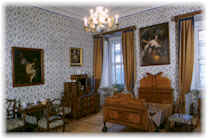
Polička nalevo od dveří ukazuje české sklo a míšenský porcelán z 18.
století. Obrázek "Stařec a dívka" datován kolem roku 1545 je pověšen
nad prádelníkem a právě tento obraz je kopii malby Lucase Cranachia. Biblická
scéna "Zuzana a dva staříci" z 18. stol. můžou být spatřeni nad
stolem. Mezi okny je velikým obrazem ze 17. století. S vyjímkou ručně
malovaných tapet a dvěmi židlemi z 19. století je pokoj v barokním stylu.
ITALSKÝ POKOJ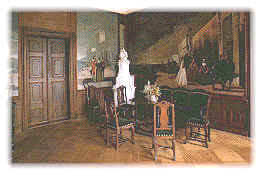
Strop je vyštukován. Když byl restaurován v roce 1993, tak byla nalezena freska
podepsaná Janem Jiřím Hertlem z Trutnova datovaná něco kolem roku
1724. Po roce 1750 Jiří Histler vytvořil olejovou malbu pokrývající stěny
s náměty Benátek a Napoleóna. Nábytek je v anglickém stylu z 18. století.
Dále je zde model Kostela Svatého Náhrobku v Jerusalémě.
HUDEBNÍ SALONEK
Poslední stavitelské změny byly provedeny v druhé poloviňe 19. století.
Tato místnost fungovala jako studovna pro účetnictví. Nábytek pochází z
18.století. Také je zde kabinet s napovrchu-vytvořenými hudebními motivy.
Malby na stěnách jsou převážně o Valdštejnech. Také jsou zde obrazy Marie
Terezie a jejího syna Josefa II.
OBRAZÁRNA
Byla vytvořena během vlády Františka Arnošta z Valdštejna (1727-1748).
Můžete zde pozorovat rozmanité sbírky maleb různých kvalit. Snad nejdůležitější
obrazy jsou David a Bétsabe vytvořený B. Strobelem z roku 1630. Ale na druhé
straně je zde řada dalších, které stojí za zhlednutí.
LOVECKÝ SALONEK
Vyštukovaný strop byl zrenovován v roce 1993 druhá fresca"Bohyně Diana
lovící" byla podepsána Janem Jiřím Hertlem datovaná na rok 1724. Zdi
jsou znovu dekorovány Hertlem s loveckými motivy. Portrét Františka Arnošta
Heřmana je pověšen přes krb a naproti visí portrét jeho syna, Vincenta. Nábytek je datován
na 18. až 19. století.
PŘIJÍMACÍ POKOJ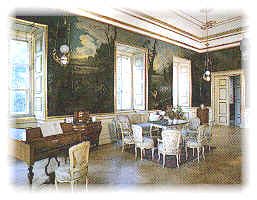
Právě se nacházíme v největší místnosti zámku. Na stěnách visí
olejové malby z loveckých scén, Zámku Mnichovo Hradiště a jeho okolí.
Jsou tady vůbec nejstarší obrazy na zámku. Autory nelze určt. Je zde
také rokokový prádelník, na kterém jsou další dvě krabičky na odložení
rukavic.
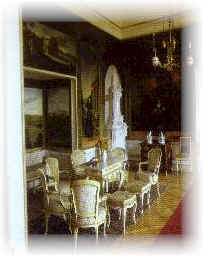
DÁMSKÝ SALONEK
Zdi jsou znovu dekorovány obrazy Jiřího Hislera představující dámy v rozdílném
rokokovém odění. Hisler zde také namaloval Klášter, ruiny Zásadky a Valečov. Nábytek
je v rokokovém stylu. Židle jsou ve stylu Ludvíka XIV. datované na první
století 18. století. Dále jsou zde olejové malby, odpočívadla, figuríny
z Míšně a vídeňský porcelán.
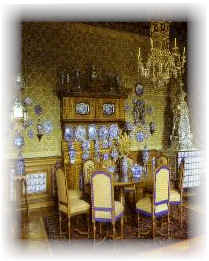
DELFTSKÁ JÍDELNA
Jídelna je v romantickém stylu a byla vytvořena na konci 19. století. Renesanční
strop byl dopraven z Dobrovického zámečku v 1860. Jedinečná sbírka
delftské keramiky je doplněna také několika italskými a německými kousky. Vysoká váza
pro 40 tulipánu se nachází v levém rohu místnosti. Několik dalších váz
je umístěno na pseudorenesanční skřínce.
ORIENTÁLNÍ POKOJ
V této místnosti jsou ukázkou Japonský a čínský porcelán ze 17. a 19. století.
Sbírka je umocňována nábytkem dělaná v Chippendalovksém stylu.
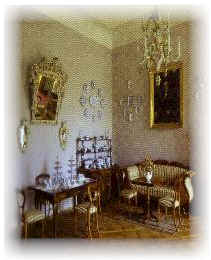
MÍŠENSKÁ JÍDELNA
Sada míšenského porcelánu s typickým vzorem cibule byla vyrobena v Míšni
v 19. století. Nábytek je v Biedermeierovském stylu. Vedle oken můžeme vidět
portréty Valdštějnovic rodiny, které byly namalovány Ant. Machkem. Zbytek
obrazů je spjat se setkáním Svaté Aliance tady na zámku. Byl zde rakouský
císař František I. s ženou C. Augustou, ruský císař Mikuláš I. a pruský
princ F. Wilhelm.
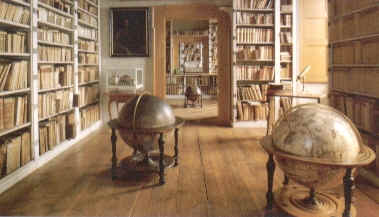 ZÁMECKÁ KNIHOVNA
ZÁMECKÁ KNIHOVNA
Tři místnosti pro knihovnu mají zhruba 20 500 knížek. Knihy jsou z 16 - 17.
století a jsou z rozdílných vědeckých odvětví. Především jsou o
botanice. Pod okny jsou umístěny Holandské glóbusy ze 17. století. Do roku
1921 se většina knížek nacházela na zámku Duchcov, kde byl známý Giacome
Casanova knihovníkem(18. století)
nahoru
nahoru
Pokud budete mít zájem podívat se na
oficiální stránku pro
Zámek Mnichovo Hradiště pak klikněte: http://www.pusc.com
-
Kvarteto Atlantis Colegium
Sobota 7.července, 17.00 hod
Barokní koncert v zámeckém divadle. Nástroje - soprán, housle, cembalo, violoncelo. Vedoucí souboru Vítězslav Podrazil -
L´Amor Generaso (šlechtická láska) - A. scarletti
Pátek až neděle, 7-9. září
Novodobá světová premiéra barokní opery v zámeckém divadle.. Hraje barokní soubor Capella Academica Praha, umělecký vedoucí Ondřej Macek. Společně s Českou Handelovou společností. -
Výstava u pokladny zámku
1.dubna - 31. října
Fotografie plastik od Vl. Hanzla, umístěných v přírodě a vytvořených na sympoziích výtvarníků 1996-2000 v Klášteře Hradišti pod záštitou Sdružení obcí "Středního Pojizeří"
Provozní doba:
leden-březen
- zavřeno
duben
- 9.00-15.00*
květen-srpen
- 9.00-16.00
září
- 9.00-15.00
říjen
- 9.00-16.00*
listopad-prosinec - zavřeno
Zavřeno v pondělí
*otevřeno pouze SO,NE a svátky
Pokud máte nějaké připomínky nebo byste chtěli něco vložit na tuto stránku, Tak prosím napiště sem
![]() Castel
Mnichovo Hradiste
top
Castel
Mnichovo Hradiste
top
top
Dear surfers,
welcome to the Mnichovo Hradiště
Castle
You are on the webpage for the Mnichovo Hradiště
Castle whose history is connected with the fate of the close located Cistercian
Monasterz. The first important owner of this castle was the leader of the Czech
Estates and Protestant opposition Václav Budovec of Budov. He order to have the
existing castel re-built to a representative seat to fit his social position.
After the Estates opposition was defeated in 1621, Budovec was executed and his
property confiscated, Albrecht of Wallenstein obtained the confiscated castle as
well as other property. In 1627 he gave this property to his cousin Maxmilian of
Wallenstein. Until 1946 the castle was owned by the House of Wallenstein and
Mnichovo Hradiště was for long time the center of the whole Wallenstein
manorial seat.
In mid 17th century the renaissance castle was re-built by builder M.A.Canavall
and M. Raimondy into the present baroque style. The development of the castle
area was basically finished in years 1709-1710 by the addition of severals
buildings as the stables, iding hall, carriage hall and salla terrena. This
additional buildings gave birth to a very exceptional valuable complex of high
baroque architecture in Bohemia.
The inspection of the historical interior of the castle starts in the corridor
on the first floor where the portraits of th e Wallenstein family are hung in
the gallery.
Interesting Rococo sleigh for ladies are exhibited here.
THE
CORRIODOR
The biggest canvas in this corridor is the genealogical tree of the Archibishop
of Litoměřice Emanuel Arnošt Wallenstein (1415-1710). On the right hand side
of the canvas you can see an interesting perosonality that of Vincenc of
Wallenstein painted in his Lodge uniform. The estates have culturaly developed
due to him. Besides other activities he also supported the composer Josef
Mysliveček during his studies and as a member of the Prague lodge he also met
W.A.Mozart. On the opposite side you can see the portrait of Marie Markéta of
Chudenice who ordered the construction of the Chapel of St. Anne.
THE
HALL
Here you can again see the family portraits of the Wallenstein and the
genelogical table of František Josef Jiří confirming his origin which was
used ontaining official posts.
On the right you can have a look into the castle chapel which was built arround
1735 to the order of Marie Markéta Černín as already afore mentioned. The
altar picture was painted by Jan Jiří Hertl of Turnov. The walls are covered
with artificial marble. Please take note of the wooden sculptures of St. August
and St. Gregory and the 18th century candle holders fashioned in the shape of
angels.
COUNTESSES ANTE-CHAMBER
Standing on the left is the lavablo from the 2nd half of the 19th century and at
the window is the model of the 18th century altar. The oil paintings placed in
the right wall two views of Naples and two of fishing scenes from Holland. Next
to the door a table picture of Dutch origin from the 17th century is displayed
picturing a ceremonial procession in Rome. Different devices for sewing and
sewing boxes decorated with opal glass are placed on the top of the commode. The
roon is being lit by a 19th century chandelier amde from coloured split glass of
Czech origin.
THE COUNTESSES BEDROOM
The secretaire on the lect of the door is displaying Czech glass and Meissen
porcelain from the 18th century. The picture "The Old man and Girl"
dated from 1545 is placed above the commode and it is a copy of Lucas
Cranach picture. An 18th century picture of biblical scene "Susan and two
old men" can be seen above the table. Between the windows is a a huge
picture from 17th century "Rebecca at the Well". With exception of the
hand painted wallpaper and the chairs upholstery from the 19th century the room
is furnished in baroque style.
THE
ITALIAN ROOM
The ceiling is stucco decorated and when it was being restored in 1993 a fresco
of an ancient god signed by Jan Hertl of Trutnov dated 1724 was discovered and
also restored. After 1750 Jiří Histler Created the oil paintings covering the
walls with views of Venice and Naples. This was created on the lines of the
enggravings of Josef Habermann. The furniture is in English style of the 18
century. Take note of the model of the Church of Holy Sepulchre in Jerusalem
inlaid with mother of pearl, ebony and ivory.
MUSICAL
ROOM
The last building changes were made in the second half of 19th century. This
room functioned as a study of the count. The furniture originates in 18th
century. Please notice the cabinet with inlay of musical motives on which you
can see the Meissen china and china from Berlin. The paintings in the walls are
mostly portraits of Wallenstein. For example Vincenc from Wallenstein and his
family. There are also two oval portraits of empress Marie Terezie and her son
Josef II. In the corner of the room you can see tiled stove which was brought
from Valdštýnsko in Bělá pod Bezdězem.
PICTURE
It was created during the ruling of František Arnošt Valdštejn (1727-1748).
You can observe a miscellaneous collection of paintings of diverse quality. The
most significant ones are the David and Betsabé by B. Strobel from 1630, two
still life paintings with flowers in the jars by K.J.Hirschely from the
beginning of 18th century and two smaller mythological paintings by a Viennese
painter M. Mannagetta signed in 1668.
HUNTING
ROOM
The stuco decoration of the ceiling wa renovated in 1993 and second fresco
"Goddess Diana hunting" signed by Jan Jiří Hertl dated 1724. was
discovered. The walls were again decorated by J.J.Hertl depicting hunting
scenes. The portrait of František Arnošt Heřman is hung over the fireplace
opposite the picture of his afore mentioned son Vincent of Wallenstein. The
furnishing of this room dates from the 18th and 19th century. Please take note
of the box on the table which is decorated with Cheb relief inlay. Game stones
with reliefs of ancient gods are placed on the box. They were used for a game
called Trik-Trak. On the left a model is placed on the commode of a military
ship most probably a Dutch one. (The flag carries the sign of Flanders).
DRAWING
ROOM
We are now in the largest room of the castle. On the walls are oil painting of
hunting scenes, castles of Mnichovo Hradiště and its surroundings. These are
the oldest pictures at the castle and authors cannot be ascertained. Take note
of the rococo settes covered with French inlaid commodes you can find small
commodes (boxes) which served for storing gloves and 4 rococo candel holders
made from white Meissen porcelain representing allegory of rivers. Rest of the
porcelain exhibited here is either Viennese or from Meissen of 18th and 19th
century. The Vienna porcelain chandeliers are petroleum(kerosene) lamps.

LADIES
DRAWING ROOM
The walls are again decorated with wall pictures of Jiří Hisler presenting
ladies in different rococo attires and in alcove the castles Klašter and on the
sides the ruins of Zásadka and Valečov can be seen. The furniture just like in
the drawing room is again in rococo style. The decorative chairs in the style of
Louis XIV. dated from the 1st half of the 18th century are here a point of
interest. You can see oil paintings placed on the arm rests. In the room you can
also find figurines of Meissen and Vienna porcelain from the same period.

THE
DELFT DINING ROOM
The dining room in romantic style was created at the end of the 19th
century. The Renaissance coffered ceiling was transfered from Dobrovice castle
in 1860. The unique collection of the Delft is comlimented by several
pieces of Italian and German Faenza majolica from 17th - 19th century. The tall
vase for 40 tulips reffered to as "pagoda" is placed in left corner of
the room. Several other vases are placed on the top of the pseudorenaissance
sideboard. In the room there are some 18th century stove tiles.
THE
ORIENTAL ROOM
Japanese and Chinese porcelain from the 17th and 19th century are on show in
this room. The collection is supplemented by furniture made in Chippendale
style.

THE MEISSEN AND DINING ROOM
A set of Meissen porcelain with the typical onion pattern manufactured in
Meissen in the19th century can be found here. The furniture is in Biedermeier
style. By the windows we can see portraits of the Wallenstein family members by
the significant painter Ant. Machek. The rest of the pictures are in connection
with the meeting of the Saint Allience which took place at Mnichovo Hradiště
in 1833 during the time of the ownership of Kristian Wallenstein. The Austrian
Emperor Francis I. with wife Caroline Augusta, the Russian Emperor Nicholas I.,
the Prussian crown prince Fridrich Wilhelm attended this meeting.
 LIBRARY
LIBRARY
The rooms of the library contain 20 500 books. The books are from 16-19th
century of different scientific fields but mostly they refer to botanic. Dutch
globes from the 17th century are placed under the windows. Up until most
of the books here could be found at the castle of Duchcov where, in 18th
century, Giacome Cassanova was the librarian
Opening times:
Jan.- March: closed
April:
- 9.00-15.00*
May-August - 9.00-16.00
September
- 9.00-15.00
October
- 9.00-16.00*
Closed on Mondays
*open only Sat., Sun., and state holidays
top
top
If you´d like to take a look into the offical webpage of Mnichovo Hradiště Castle then CLICK HERE:
Tento text jsem čerpal z anglického překladu
pro prohlídku na zámku. Pokud budete mít nějaké připomínky nebo nějaké
další informace o zámku, tak je prosím zasílejte » ZDE.
Za každý další přínos Vám budu velice vděčný. Děkuji.
